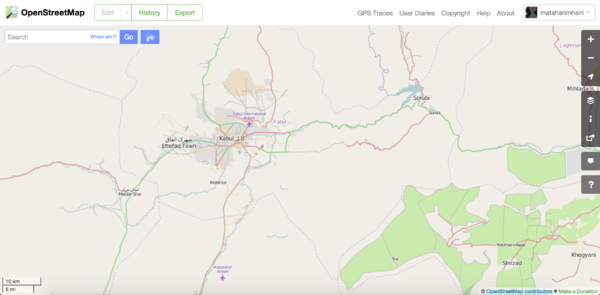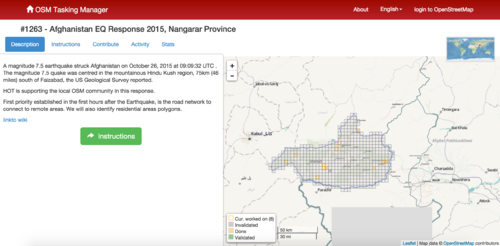2015 Eastern Afghanistan Earthquake
| General Information | |
|
The 2015 Eastern Afghanistan Earthquake hit remote areas of Afghanistan and Pakistan on Monday the 26th October with a magnitude of 7.5, with a series of tremors, measuring 4.0 or higher striking west of the original epicentre in the following hours. The US Geological Survey (USGS) reported that the earthquake was centred in the mountainous Hindu Kush region, 76km (45 miles) south of Fayzabad, in Badakhshan province. What We Do Who Can Use Our Maps? How To Get Involved
Coordination
Donate Donate to the OpenStreetMap Foundation The Humanitarian OpenStreetMap Team also need your donations, to help funding humanitarian mapping projects and development/maintenance of systems such as the Tasking Manager. | |
For Aid Organizations
Map and Data Services
About OpenStreetMap
OpenStreetMap offers an online map (and spatial database) which is updated by the minute. Various tools and services allow data extracts for GIS specialists, Routable Garmin GPS data, Smartphone GPS navigation, and other device-compatible downloads. With an internet connection, regular syncing is possible with open access to the community contributed data as it comes in, with OpenStreetMap's bulk data downloads ideal for use offline. In addition, maps can also be printed to paper.
Browse the Activation Area to get a feel for the data that is currently available. Different map styles including an Humanitarian style can be selected on the right side, and some data may not render (appear) on the map, but could be exported from the underlying database (See export section below).
Paper Maps
Poster size Maps and normal sized paper atlases of custom areas can be printed:
- FieldPapers Paper Maps with grid for field survey or general navigation purposes,
- MapOSMatic Large Paper Maps with grid, street index and POI, good for command centers, hospitals, etc.
Exporting OpenStreetMap data
See Downloading data for instructions on getting large scale map data. See Shapefiles if you need this format to export to GIS tools.
With the availibility of Small communication devices, Navigation Offline data proves to be very useful to the humanitarians deployed in foreign countries. We support the humanitarian NGO's using navigation data and invite them to give us feedback on the utilization of these devices in the context of field deployment.
- Bihourly updated data files for the offline navigation app Maps.me are available in this directory.
Usage of OSM data for Humanitarian Missions
About This Activation
About HOT
- To learn more about the Humanitarian OpenStreetMap Team (HOT), explore more of our wiki-pages (root: HOT) or our website hotosm.org. We are a global community of mostly volunteers, we are also a US Nonprofit able to contract with organizations (email info at hotosm.org to contact our staff), we are also a 501-c-3 charitable organization.
History of this Activation
On behalf of HOT, Russell Deffner announced that the organisation was Activating for the Eastern Afghanistan Earthquake. Russell Deffner is the Activation Lead for this event with support from Maning Sambale as well as a great group of HOT community members. Please contact Activation@hotosm.org with questions regarding this Disaster Mapping Program.
Tools, Adaptation and Services
The various OSM developers communicate over internet through various communication channels. In 2013 they implemented the new Humanitarian Map Style, a map more adapted to humanitarian actions. This map, hosted by OpenStreetMap - France, is integrated in various online map tools.
The Tasking Manager and the JOSM editor are essential parts of this Activation. As new imagery are available, new jobs are added to the Tasking Manager. It has allowed HOT to coordinate efforts of mappers around the world. Some days there were more then 200 simultaneous mappers registered on the Task Manager and editing mainly with the JOSM editor. Online editors are also used for less intensive mapping. LearnOSM offers learning material for beginners and more advanced mappers.
Coordination
- Volunteer Leads: Russell Deffner and Maning Sambale
- HOT Activation Working Group | activation@hotosm.org
Support Team
Mhairi O'Hara, Adityo Dwijananto, and Hameed Tasal are supporting this Activation.
Status Updates
Media coverage
Other Responses
For Mappers
How You Can Contribute
Learn to Map
- Most of our volunteer needs are for remote OSM contributors, visit LearnOSM.org to get started.
- If step by step videos work better for you these videos will get you from zero to mapping fast: Mapgive Learn to Map Videos
Mapping Priority
- Please choose from highest priority first
- Experienced mappers are also asked to participate in validating completed tasks. Information on validating can be found here
| Project | Priority | Location | What to map | Imagery Source | Task Mapping Status | Task Validation Status |
|---|---|---|---|---|---|---|
| #1300 | Medium | Baharak, Jurm and Kishim Districts | Roads and Residential Areas | Bing/Mapbox | Target Area Complete | Target Area Complete |
| #1264 | Low | Takhar-Badakhsan Province | Roads and Residential Areas | Bing/Mapbox | Target Area Complete | Target Area Complete |
| #1263 | Low | Nangarar Province | Roads and Residential Areas | Bing/Mapbox | Target Area Complete | Target Area Complete |
Available Imagery
The imagery in the area of these Projects is variable; Bing seems good for most of the area, but it may be necessary to switch between Bing and Mapbox where there are gaps.
Bing
Bing is the 'default' Imagery available for OSM (default option in most editors). There are areas missing from Bing, alternative imagery sources may be provided in the Task Manager Jobs, and/or described below.
Mapbox
Mapbox Imagery is available, and has recently been updated for the area in projects 1263 and 1264
Potential Datasources
Edit-a-thon events
- If you are organizing an event, please add a link here...
Past Events
- AIMS_Roads_Import - road import in 2010


